Pfaff hobby 1042 User Manual [nl]
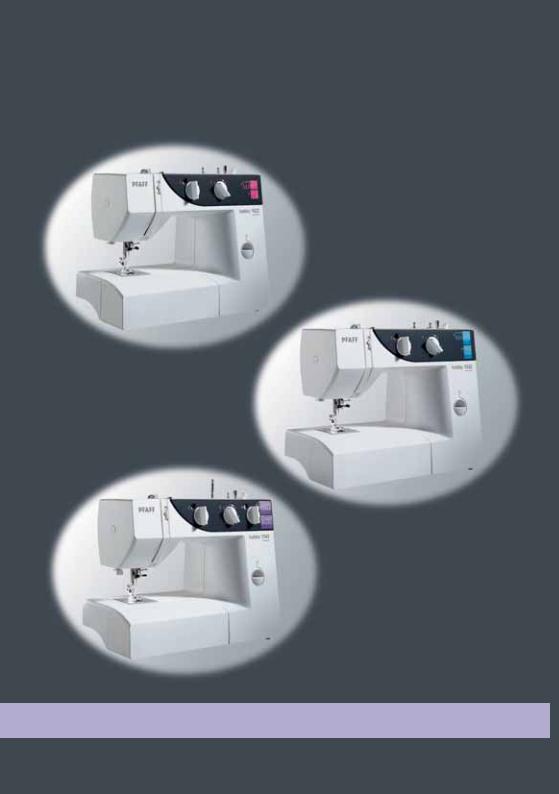
hobby
1022
1032
1042
Instruction manual
This household sewing machine is designed to comply with IEC/EN 60335-2-28 and UL1594
IMPORTANT SAFETY INSTRUCTIONS
When using an electrical appliance, basic safety precautions should always be followed, including the following:
Read all instructions before using this household sewing machine.
DANGER - To reduce the risk of electric shock:
•A sewing machine should never be left unattended when plugged in. Always unplug this sewing machine
from the electric outlet immediately after using and before cleaning.
•Always unplug before relamping. Replace bulb with same type rated 15 Watt.
WARNING - To reduce the risk of burns, Àre, electric shock, or injury to persons:
•Do not allow to be used as a toy. Close attention is necessary when this sewing machine is used by or
near children or inÀrm person.
•Use this sewing machine only for its intended use as described in this manual. Use only attachments
recommended by the manufacturer as contained in this manual.
•Never operate this sewing machine if it has a damaged cord or plug, if it is not working properly, if it has
been dropped or damaged, or dropped into water. Return the sewing machine to the nearest authorized
dealer or service center for examination, repair, electrical or mechanical adjustment.
•Never operate the sewing machine with any air openings blocked. Keep ventilation openings of the
sewing machine and foot controller free from the accumulation of lint, dust, and loose cloth.
•Keep Àngers away from all moving parts. Special care is required around the sewing machine needle.
•Always use the proper needle plate. The wrong plate can cause the needle to break.
•Do not use bent needles.
•Do not pull or push fabric while stitching. It may deÁect the needle causing it to break.
•Switch the sewing machine off (“0”) when making any adjustment in the needle area, such as threading
needle, changing needle, threading bobbin, or changing presser foot, etc.
•Always unplug the sewing machine from the electrical outlet when removing covers, lubricating, or when
making any other user servicing adjustments mentioned in the instruction manual.
•Never drop or insert any object into any opening.
•Do not use outdoors.
•Do not operate where aerosol (spray) products are being used or where oxygen is being administrated.
•To disconnect, turn all controls to the off (“0”) position, then remove plug from outlet.
•Do not unplug by pulling on cord. To unplug, grasp the plug, not the cord.
SAVE THESE INSTRUCTIONS
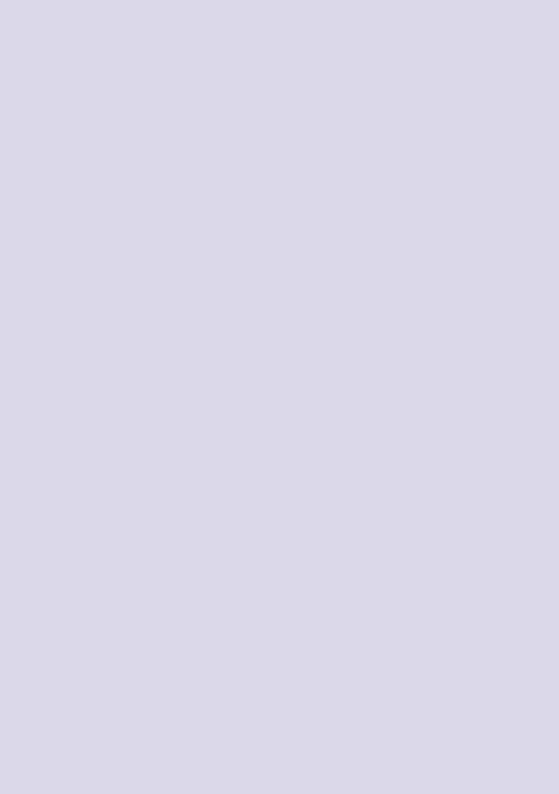
Sewing for fun
hobby
Congratulations! You have bought a quality product made by Pfaff which is sure to bring you countless hours of sewing pleasure. Your new sewing machine features the very latest in design and technology. Furthermore, it has numerous practical features which will make sewing much easier for you.
Your sewing machine is as simple to operate as this instruction manual is to follow. Before you start sewing, please take the time to read these instructions carefully. It is certainly time well spent, and is the best way to find out just what your machine can do and make full use of all its features.
If you have any further questions, just ask your Pfaff dealer, who will be happy to assist you with help or advice.
We wish you many enjoyable hours creating your very own fashion ideas.
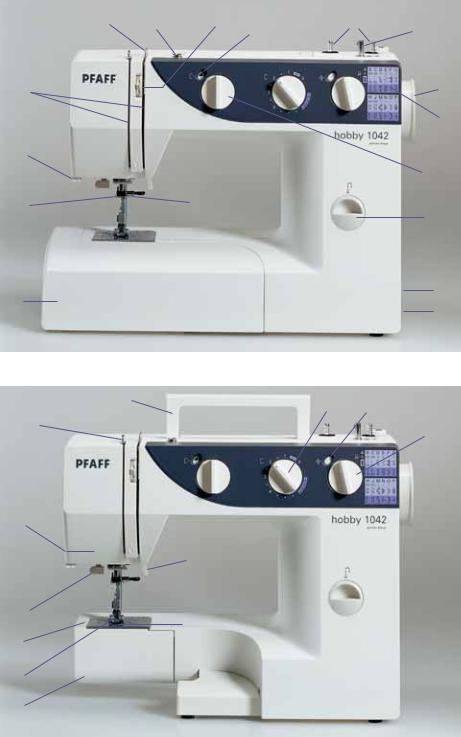
1 |
2 |
3 |
4 |
5 |
6 |
|
|
|
|
||
18 |
|
|
|
|
7 |
|
|
|
|
|
|
|
|
|
|
|
8 |
17 |
|
|
|
|
|
|
|
|
|
|
9 |
15 |
|
16 |
|
|
10 |
|
|
|
|
|
14 
13
11
12
29 |
30 |
31 |
|
28 |
32 |
|
27
26
25 
 23
23
24
22
21
20
19
Parts of the sewing machine hobby 1042
1Thread guide
2Bobbin winder tension
3Needle thread tension
4Adjustment field
5Spool holder
6Bobbin winder
7Handwheel
8Stitch pattern chart with presser foot
9Pattern adjustment button
10Reverse key
11Connection bushing
12Master switch
13Detachable work support with accessory box
14Needle plate
15Thread guide
16Thread guide
17Thread cutter
18Threading slot
19Hook cover (enclosing sewing hook)
20Presser foot holder with presser foot
21Free-arm
22Feed dog
23Needle holder with fixing screw
24Buttonhole lever
25Thread guide
26Presser bar lifter
27Sewing lamp (max. 15 W)
28Take-up lever
29Carrying handle
30Stitch length adjustment button
31Adjustment field
32Stitch width adjustment button

1 |
2 |
3 |
4 |
5 |
6 |
|
|
|
|
||
18 |
|
|
|
|
7 |
|
|
|
|
|
|
|
|
|
|
|
8 |
17 |
|
|
|
|
|
|
|
|
|
|
9 |
15 
 16
16
14 
13
29 |
30 |
|
28
27
26
25 
 23
23
22
21
20
19
10
11
12
Parts of the sewing machine hobby 1022 and 1032
1Thread guide
2Bobbin winder tension
3Needle thread tension
4Adjustment field
5Spool holder
6Bobbin winder
7Handwheel
8Stitch pattern chart with presser foot
9Pattern adjustment button
10Reverse key
11Connection bushing
12Master switch
13Detachable work support with accessory box
14Needle plate
15Thread guide
16Thread guide
17Thread cutter
18Threading slot
19Hook cover (enclosing sewing hook)
20Presser foot holder with presser foot
21Free-arm
22Feed dog
23Needle holder with fixing screw
25Thread guide
26Presser bar lifter
27Sewing lamp (max. 15 W)
28Take-up lever
29Carrying handle
30Stitch length adjustment button

hobby – Sewing for fun
Index
A
Accessories and needles |
53 |
Accessory compartment |
11 |
B
Bias tape binder |
56 |
Blind-stitch foot |
28 |
Bobbin case |
14-15 |
Borders, embroidering |
50 |
Buttonholes |
33-37 |
Buttons |
29 |
C
Changing the needle |
20 |
Changing the sewing lamp |
63 |
Cleaning and oiling |
62 |
Closed overlock stitch |
32 |
Control panel |
21 |
Cording foot |
57 |
D
Darning |
42 |
Detachable work support |
11 |
Drawing up the bobbin thread |
18 |
E
Edge guide |
26 |
Elastic blind stitch |
28 |
Elastic stitch |
31 |
Elastic stitches |
30-32 |
Electrical connection |
10 |
Embroidering with the twin needle |
50 |
F
Fancy stitches |
22 |
Feed dog, lowering |
20 |
Felling foot |
57 |
Foot control |
10 |
Free arm |
11 |
G
Gathering with the elastic thread |
41 |
Gathering with the straight stitch |
40 |
General sewing aids |
25 |
H
Handwheel, releasing |
12 |
Hemming with the twin needle |
38 |
Hemstitching |
52 |
Honeycomb stitch |
31 |
Hook, removing |
62 |
K
Knit-edge foot |
58 |
L
Lace-work |
47 |
Linen buttonhole |
34 |
Linen buttonhole with gimp thread |
34 |
M
Maintenance |
61 |
Master switch |
10 |
N
Needle charts |
59-60 |
Needle plate, removing |
63 |
Needle thread tension |
26 |
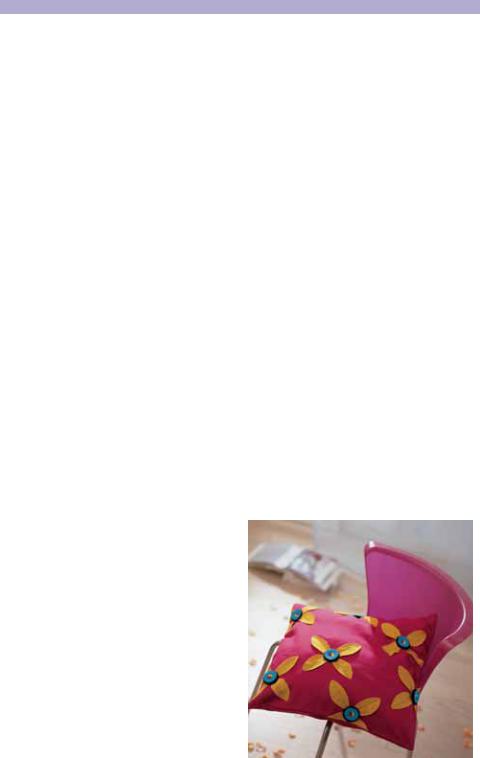
hobby – Sewing for fun
O |
|
Stitch density |
23 |
|
Oiling the machine |
62 |
Stitch length adjustment button |
23 |
|
One step buttonhole |
35-37 |
Stitch width adjustment button |
24 |
|
Open overlock stitch |
32 |
Straight stitch |
27 |
|
Overlock stitches |
32 |
Stretch stitches, adjusting |
23 |
|
|
|
Stretch triple straight stitch |
30 |
|
P |
|
Stretch triple zigzag stitch |
30 |
|
|
|
|
||
Patchwork quilt |
51 |
|
|
|
Practical sewing |
25 |
T |
|
|
Presser bar lifter |
17 |
Thread cutter |
18 |
|
|
|
Thread tension |
14 |
|
Q |
|
Threading |
16-17 |
|
|
Threading the needle thread |
16 |
||
Quilt and patchwork foot |
58 |
|||
Topstitching |
26 |
|||
|
|
|||
|
|
Traditional embroidery techniques |
49 |
|
R |
|
Troubleshooting |
64 |
|
Repairing tears |
43 |
Twin needle |
38 |
|
Reverse sewing |
24 |
|
|
|
Richelieu |
50 |
W |
|
|
Roll hemming |
46 |
|
||
Winding the bobbin |
12-13 |
|||
RufÁer |
56 |
|||
|
|
|||
S |
|
Z |
|
|
|
Zigzag stitch |
27 |
||
Safety notes |
2 |
|||
Zippers |
44-45 |
|||
Serging with the blind stitch foot |
28 |
|||
|
|
|||
Serging with the zigzag stitch |
27 |
|
|
|
Setting utility stitches |
22 |
|
|
|
Sewing feet (normal accessories) |
54 |
|
|
|
Sewing feet (special accessories) |
55 |
|
|
|
Sewing lamp |
63 |
|
|
|
Sewing on patches |
42 |
|
|
|
Sewing problems and their solutions 64 |
|
|
||
Shell edging |
48 |
|
|
|
Smocking |
39 |
|
|
|
Special accessories chart |
55 |
|
|
|
Spool placement |
12 |
|
|
|
Stitch chart |
6, 7, 8 |
|
|
|
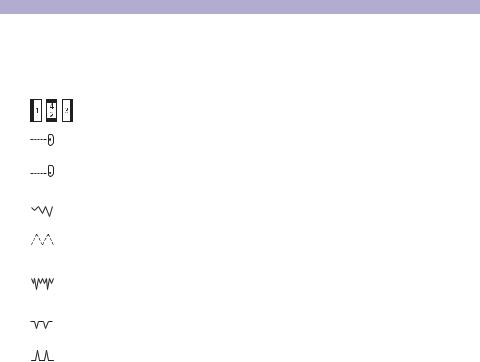
hobby – Sewing for fun
hobby 1022 – Stitch chart
For these programs the stitch length can be set anywhere between 0 and 4 mm with the aid of the stitch length adjustment button (30).
Program |
Name |
Application |
|
Buttonhole A3, A4/2, A1 |
Standard buttonhole for e.g. blouses |
|
|
and bed linen |
B |
Straight stitch |
For all straight stitch |
|
needle position middle |
and lockstitch work up to 4 mm |
|
|
|
C |
Straight stitch |
For all sewing and topstitch work requiring a |
|
needle position left |
left needle position, stitch width 2 mm |
|
|
|
D |
Zigzag stitch |
For serging and appliqué, stitch width 5 mm |
|
|
|
E |
Elastic stitch |
For stitching on elastic band, |
|
|
darning tears and patches |
|
|
|
F |
Elastic blind stitch |
For invisible hem attachment and |
|
|
simultaneous serging. |
|
|
Also for stretch fabrics. |
G |
Blindstitch |
For invisible hem attachment |
|
|
|
H |
Shell-edging stitch |
For decorative hems on Àne materials, e.g. linen |
|
|
|
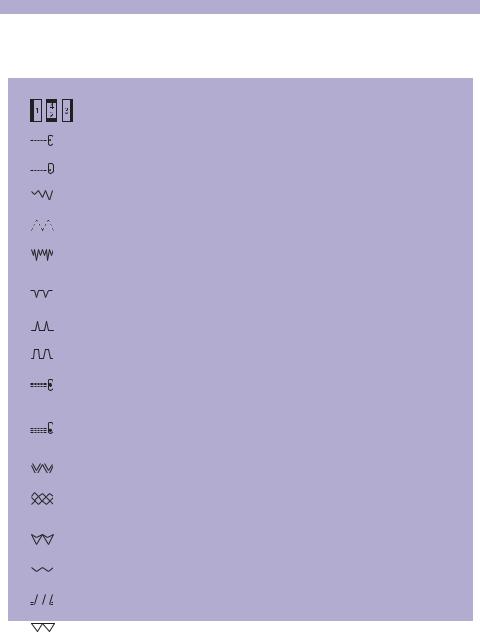
hobby – Sewing for fun
hobby 1032 – Stitch chart
For these programs the stitch length can be set anywhere between 0 and 4 mm with the aid of the stitch length adjustment button (30).
Program |
Name |
Application |
|||||||||
|
|
|
|
|
|
|
|
|
|
|
|
|
|
|
|
|
|
|
|
|
|
Buttonhole A3 A4/2 A1 |
Standard buttonhole for e.g. blouses and |
|
|
|
|
|
|
|
|
|
|
|
bed linen |
B |
Straight stitch |
For all straight stitch and lockstitch work |
|||||||||
|
|
|
|
|
|
|
|
|
|
needle position middle |
up to 4 mm |
|
|
|
|
|
|
|
|
|
|
|
|
C |
Straight stitch |
For all sewing and topstitch work |
|||||||||
|
|
|
|
|
|
|
|
|
|
needle position left |
requiring a left needle position |
D |
Zigzag stitch |
For serging and appliqué, stitch width 5 mm |
|||||||||
|
|
|
|
|
|
|
|
|
|
|
|
E |
Elastic stitch |
For stitching on elastic band, |
|||||||||
|
|
|
|
|
|
|
|
|
|
|
darning tears and patches |
F |
Elastic blind stitch |
For invisible hem attachment and simultaneous |
|||||||||
|
|
|
|
|
|
|
|
|
|
|
serging. Also for stretch fabrics |
|
|
|
|
|
|
|
|
|
|
|
|
G |
Blind stitch |
For invisible hem attachment |
|||||||||
H |
Shell-edging stitch |
For decorative hems on Àne materials, |
|||||||||
|
|
|
|
|
|
|
|
|
|
|
|
|
|
|
|
|
|
|
|
|
|
|
e.g. linen |
J |
Greek stitch |
A classical decorative stitch e.g. for borders |
|||||||||
|
|
|
|
|
|
|
|
|
|
|
and towels |
B |
Stretch triple straight |
For stretch seams, e.g. crotch seams on sports- |
|||||||||
|
|
|
|
|
|
|
|
|
|
stitch, needle pos. middle |
and workwear |
|
|
|
|
|
|
|
|
|
|
|
|
C |
Stretch triple straight |
For stretch seams requiring a left needle position |
|||||||||
|
|
|
|
|
|
|
|
|
|
stitch, needle position left |
|
D |
Stretch triple- |
For attaching elastic tape on elastic materials |
|||||||||
|
|
|
|
|
|
|
|
|
|
|
|
|
|
|
|
|
|
|
|
|
|
zigzag stitch |
|
E |
Honeycomb stitch |
For sewing on elastic threads, overlocking and for |
|||||||||
|
|
|
|
|
|
|
|
|
|
|
decorative hem seams |
F |
Edge stitch |
For closing and serging one or more fabric layers |
|||||||||
|
|
|
|
|
|
|
|
|
|
|
|
|
|
|
|
|
|
|
|
|
|
wide |
|
|
|
|
|
|
|
|
|
|
|
|
|
G |
Edge stitch |
For closing and serging one or more fabric layers |
|||||||||
|
|
|
|
|
|
|
|
|
|
narrow |
|
H |
|
|
|
|
|
Open overlock stitch |
A closing and serging seam for stronger |
||||
|
|
|
|
|
|||||||
|
|
|
|
|
|
|
|
|
|
|
|
|
|
|
|
|
|
|
|
|
|
|
or non-fraying materials |
J |
Closed overlock stitch |
A closing and serging seam for fraying materials |
|||||||||
|
|
|
|
|
|
|
|
|
|
|
|

hobby – Sewing for fun
hobby 1042 – Stitch chart
For these programs the stitch length can be set anywhere between 0 and 4 mm with the aid of the stitch length adjustment button (30).
To alter the stitch width from 0 to 5, use the stitch width adjustment button (32).
Program |
Name |
Application |
|||||
A |
Buttonhole |
Standard buttonhole for e.g. blouses and bed linen |
|||||
|
|
|
|
|
|
|
|
B |
Straight stitch, |
For all straight stitch and lockstitch work up to |
|||||
|
|
|
|
|
|
needle position middle |
to 4 mm |
C |
Straight stitch, |
For all sewing and topstitch work requiring a left |
|||||
|
|
|
|
|
|
needle position left |
needle position. |
D |
Zigzag stitch |
For serging and appliqué |
|||||
|
|
|
|
|
|
|
|
E |
Elastic stitch |
For stitching on elastic band, |
|||||
|
|
|
|
|
|
|
darning tears and patches |
F |
Elastic blind stitch |
For invisible hem attachment and simultaneous |
|||||
serging. Also for stretch fabrics. |
|
||||||
|
|
|
|
|
|
|
|
G |
Blind stitch |
For invisible hem attachment |
|||||
|
|
|
|
|
|
|
|
H |
Shell-edging stitch |
For decorative hems on Àne materials, e.g. linen |
|||||
|
|
|
|
|
|
|
|
J |
Greek stitch |
A classical decorative stitch e.g. for |
|||||
|
|
|
|
|
|
borders on towels |
|
B |
Stretch triple straight |
For stretch seams, |
|||||
|
|
|
|
|
|
stitch, needle pos. middle |
e.g. crotch seams on sportsand workwear |
|
|
|
|
|
|
|
|
C |
Stretch triple straight |
For stretch seams requiring a left needle position |
|||||
|
|
|
|
|
|
stitch, needle pos. left |
|
|
|
|
|
|
|
|
|
D |
Stretch triple |
For attaching elastic tape on elastic materials |
|||||
|
|
|
|
|
|
zigzag stitch |
|
|
|
|
|
|
|
|
|
E |
Honeycomb stitch |
For sewing on elastic threads, |
|||||
|
|
|
|
|
|
|
overlocking towelling |
|
|
|
|
|
|
|
and for decorative hem seams |
F |
Edge stitch |
For closing and serging one or more fabric layers |
|||||
|
|
|
|
|
|
wide |
|
G |
|
|
|
|
|
Edge stitch |
For closing and serging one or more fabric layers |
|
|
|
|
|
|||
|
|
|
|
|
|
narrow |
|
H |
Open overlock stitch |
A closing and serging seam for stronger or |
|||||
|
|
|
|
|
|
|
non-fraying materials |
J |
Closed overlock stitch |
A closing and serging seam for fraying materials |
|||||
|
|
|
|
|
|
|
|
Ornamental stitches for hobby 1042
M N O P
Application: Embroidery, e.g. on blouses, children·s wear and household textiles.
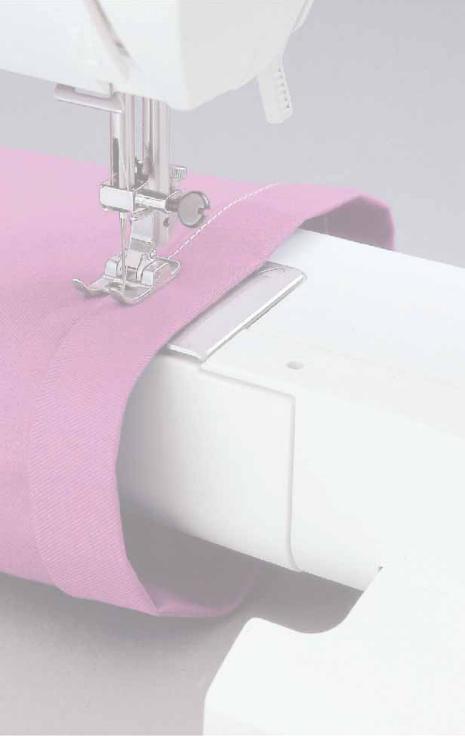
Operating the machine
Bobbin winding |
12-13 |
Bobbin case |
14 |
Changing the needle |
20 |
Changing the presser foot |
19 |
Control panel |
21 |
Detachable work support |
11 |
Drawing up the bobbin thread |
18 |
Electrical connection |
10 |
Free arm |
11 |
Lowering the feed dog |
20 |
Needle thread tension |
20 |
Presser bar lifter |
17 |
Reverse serging |
24 |
Setting the utility stitches |
22 |
Setting the stretch stitches |
23 |
Threading the needle thread |
16-17 |
Thread cutter |
18 |
9
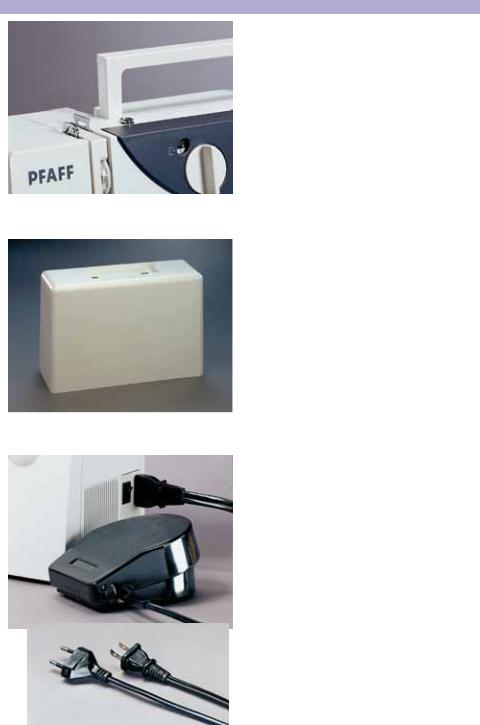
Operating the machine
120 V
220 V
Carrying handle
Lift up the carrying handle of the sewing machine from behind.
Carrying case
The carrying case, which is part of the basic equipment, protects your sewing machine from dust and damage during transport.
Before putting on the carrying case, lift up the carrying handle. Make sure the sewing machine symbol on the carrying case is pointing toward you.
 Electrical connection
Electrical connection
Connect the plug of the foot pedal to the connection bushing (11) on the sewing machine and the electrical socket.
The sewing speed is regulated by pressing the foot pedal. For this sewing machine has to be used foot controller TJC-211 (220-240V) or TJC-150 (120V).
 Master switch
Master switch
The sewing lamp lights up when the master switch (12) is turned on. The machine is now ready to sew.
10
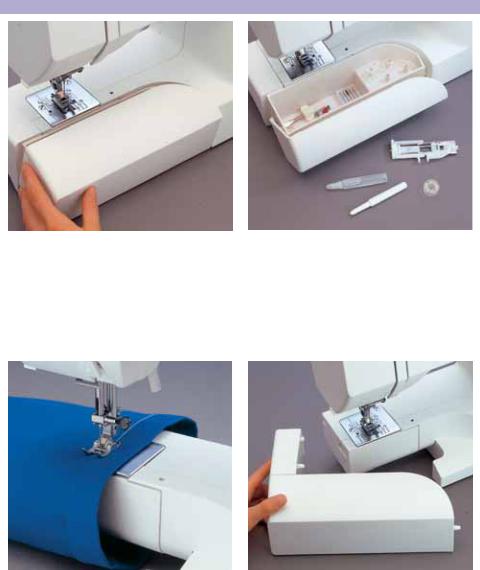
Operating the machine
Accessory compartment
The accessory compartment is found underneath the detachable work support (13), that has to be opened.
Removing the detachable work support /free arm
In order to be able to sew with the free arm, you must swing the detachable work support (13) to the left and lift it out of the hole.
Organizing the accessories
Place the enclosed accessories into the accessory compartment.
Inserting the detachable work support
Push the pins of the detachable work support (13) from the left fully into the holes provided.
When inserting the detachable work support, make sure that it is Áush with the free arm of the sewing machine.
11
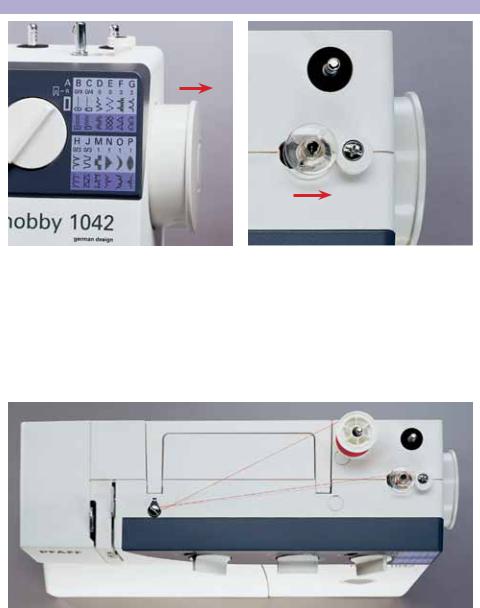
Operating the machine
Preparing the machine for bobbin winding
Pull the handwheel (7) fully to the right. This will prevent the needle moving while the machine is winding the bobbin.
Mounting the bobbin
Switch off the master switch (12)
Place the empty bobbin onto the pin of the bobbin winding mechanism and press it down as far as possible. Push the bobbin to the right.
Note: The bobbin can only be wound if it is moved fully to the right.
Winding the bobbin
Pull the spool holder (5) up and place a spool on it.
Place the thread clockwise into the bobbin winder tension (2) and run it to the bobbin. Wind the thread clockwise around the bobbin several times.
Turn the master switch (12) on and press the foot pedal.
Let go of the thread after a few revolutions. As soon as the bobbin is full the winding action will be stopped automatically. Press the full bobbin to the left and remove it from the pin.
12
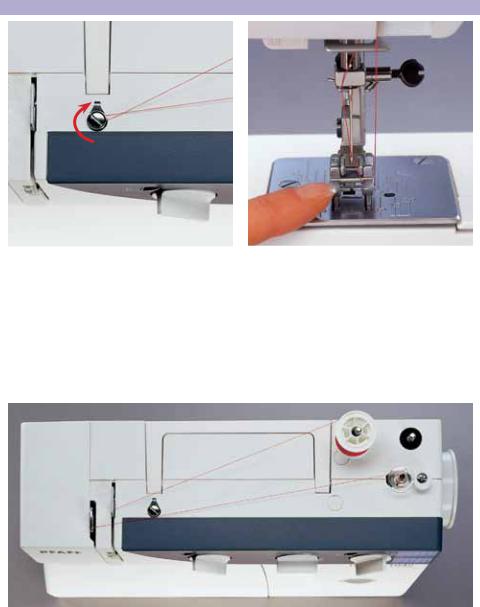
Operating the machine
Bobbin winder tension
Pass the thread through the bobbin thread tension (2) in a clockwise direction, so that it crosses over itself on the way to the bobbin.
Winding a bobbin through the needle
It is possible to wind bobbins even when the machine is threaded. Raise the presser bar lifter (26) to the top position. Pull the thread underneath the presser foot.
Pull the thread upward through the left-hand threader slot (18). Place the thread from left to right through the take-up lever (28). Wind the beginning of the thread several times around the bobbin in a clockwise direction. Hold the end of the thread Àrmly and press the foot pedal.
Tip: While winding the bobbin, gently push down the front of the presser foot with your finger.
Don·t forget: After winding a bobbin, press the handwheel (7) back to the left!
13
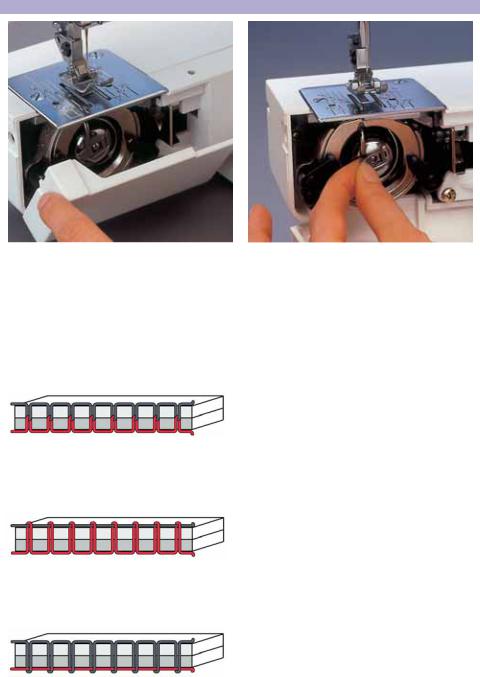
Operating the machine
Hook cover
 Switch off the master switch (12).
Switch off the master switch (12).
Hold the side of the hook cover (19) and open it towards you.
Taking out the bobbin case
Lift the latch of the bobbin case and pull the bobbin case out. Release the latch and take out the empty bobbin.
Thread tension
In order to achieve a perfect seam appearance and durability make sure the needle tension is correctly adjusted, so that the thread interlace is not visible on both sides of the fabric.
The following is valid for general sewing work:
Thread interlace is visible on the top side of the fabric:
•The needle thread tension is too tight .
•The thread tension must be lowered.
Thread interlace is visible on the underside of the fabric:
•The needle thread tension is too loose.
•The thread tension must be raised.
•For fancy stitches, buttonholes and darning the thread interlace should be visible on the underside of the fabric.
14
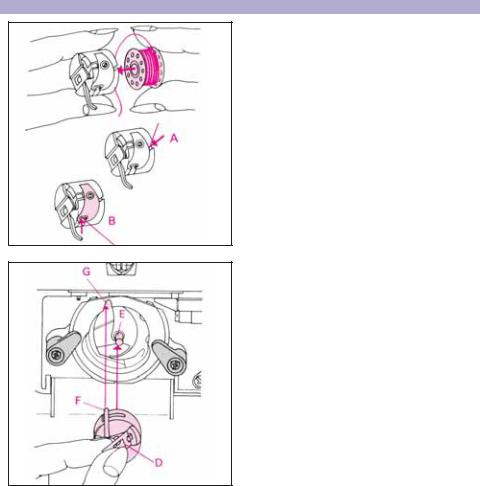
Operating the machine
Inserting the bobbin
Insert the full bobbin in the bobbin case. When doing so, pull the thread sideways through slot A and then under tension spring B so that it rests in the opening (see arrow).
Inserting the bobbin case
Lift latch D and push the bobbin case fully onto pin E of the sewing hook. The bobbin case Ànger F must point into cutout G.
Check:
Pull the bobbin thread sharply. The bobbin case must not fall out of the hook.
15
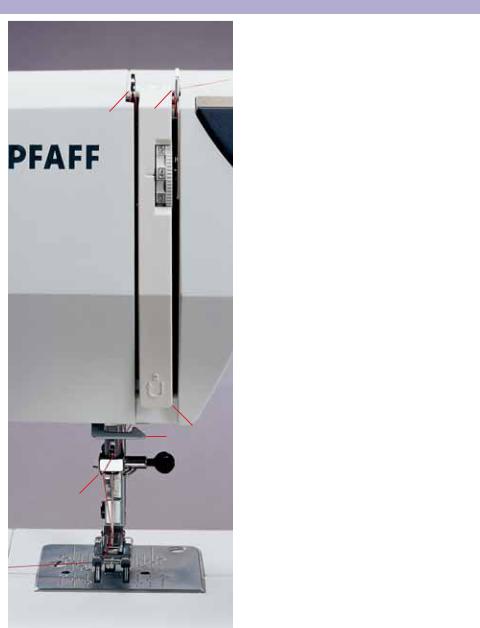
Operating the machine
C A
D B
E
Threading the needle thread
 Switch off the master switch (12).
Switch off the master switch (12).
Pull the spool holder (5) up and mount the thread. Raise the presser bar lifter (26). Turn the handwheel until the take-up lever (28) is at its highest position.
Thread by following the steps A to E.
Tip:
All the thread guides have an opening in which you can simply lay the threads.
16
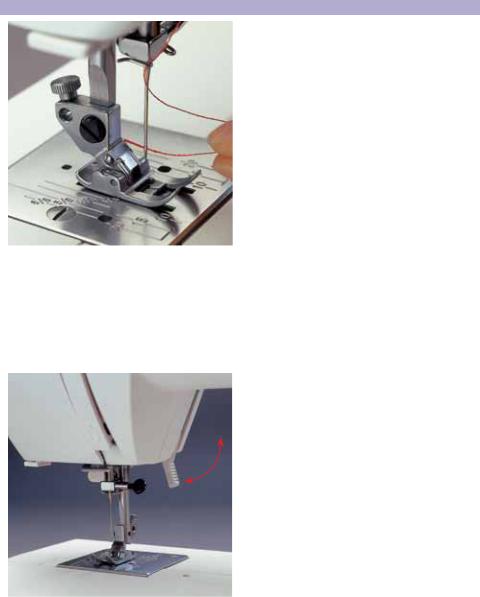
Operating the machine
Threading the needle
Thread the needle thread through the eye of the needle from the front to the back.
Presser bar lifter
The presser foot is raised and lowered with the presser bar lifter (26).
17
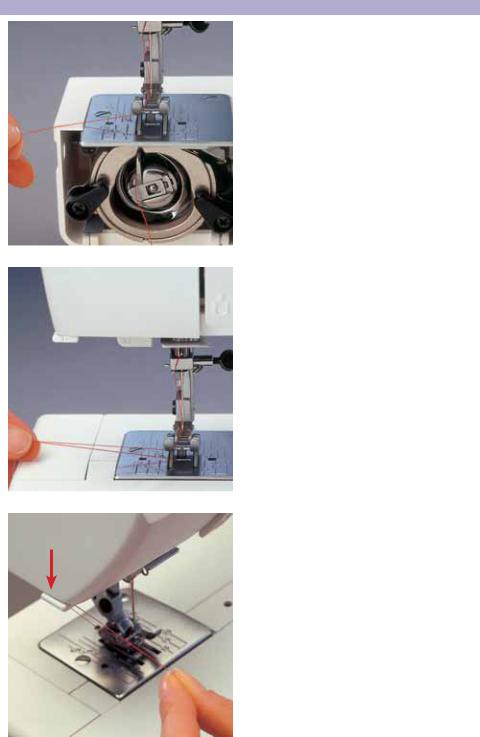
Operating the machine
Drawing up the bobbin thread
Raise the presser foot. Hold the needle thread and turn the handwheel towards you until the needle is at its highest position and the bobbin thread has formed a loop. Pull the needle thread to draw up the bobbin thread.
Bobbin thread
Close the hook cover (19) and pull the thread under the presser foot to the left.
Thread cutter
Pull the thread from the back to the front over the thread cutter (17).
18
